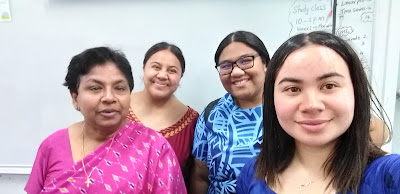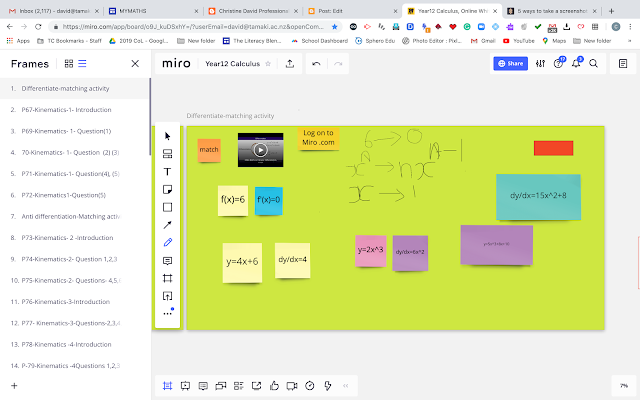My Inquiry focus for 2020:
How can I accelerate learning in my Year 12 calculus mix ability class so that Maori students (and other students) can gain at least 14 credits, endorsements, and pathways into the year 13 Calculus course. Our focus was on Algebraic skills and literacy strategies to promote contextually based questions.
My Personal Goal as an Assistant HOD was to increase learners’ Mathematics achievement in year 12 and Year 13.
As a within school COL leader, I am very confident that these two goals would make a
a powerful contribution to the school goal, Dept Goal as well as Manaiakalani goal.
The catalytic aspect of student learning in my inquiry focused on promoting self-efficacy, independent learning, and differentiation. I identified this as my focus from my past experience as students were finding it difficult to do homework. Students faced difficulty in rewinding their learning, managing time and left everything to the last minute especially when trying to understand Merit and Excellence questions.
To build up a rich picture of my learners, I used NCEA results from previous years, student voice, Pre-test/Post-test/halfway test/end of topic test, and their Mid-year examination and mock examination.
This is a mixed ability class of 22 consisting of; 3 Maori students, 10 Tongan students, 5 Samoan students, 3 Cook Island Maori, and 1 Asian. This class has great diversity and last year only two of these students endorsed with merit.
There are four different types of learners in this class. One group came from Year11 Algebra, the second group came from general Maths course, the third group came from ESOL class and another student did year9 mathematics dropped school and joined this class. One group was working at the Achieved level, the second group was working at the Merit level, the third group was working at the Excellence level and the last group was working below the Achieved level.
My challenge was to accelerate the learning pathway for these students to year 13 calculus, enter them into calculus scholarship next year and support these students to gain 14+ credits which is a Diploma entry-level qualification.
The profiling of my own teaching showed that I had strengths in teaching up to scholarship
level and meeting the needs of mixed ability students.
Two key ideas that I used were that students would likely make more progress if I facilitated more practice in literacy skills and Algebraic skills. I then ask learners to give me feedback in improving my own teaching pedagogy.
The changes I made in my teaching were after the first lockdown, causal steps in literacy strategies, student assisted learning, matching activity using Miro online board, tracking sheet, setting lessons on google calendar, testing periodically, and Miro lessons for external topics to create rewindable learning during the lockdown.
As I get closer to externals I tweaked monitoring their progress weekly by doing now activities and weekly tests to improve their accuracy skills.
Literacy strategies played a huge part in calculus so I used the KWL chart, chunk check
chew strategy, PEEL structure literacy specialist. I also involved Dr. Jannie’s ideas to unpack
M/E Algebraic contextual based questions and the literacy specialist Mrs. Latu to observe my class to cater effectively to my ESOL students.
The easiest thing is teaching to use online packages-desmos and GeoGebra to teach
Systems of equations (2.14)), Graphs(2.2).
The hardest thing is how to promote differentiated teaching and fit in my Calculus
extension program. I did lots of after school/holiday hours to make this happen at school as well as online Saturday classes. There has been a huge commitment between my students, parents, and myself to make this happen. This year I divided them into groups due to their availability and covid restrictions.
Overall I would rate the changes in student learning as impressive. Whanau helped me engage disengaged students and the partnership with family worked better in front of the parents. As a result, they engaged in this course and started to enjoy it. I offered 4 internals, including Graph internal which I introduced to enhance their Algebraic skills. There are 20 students who are willing to sit one external and five who are willing to sit two externals at the end of the year.
All my learners have finished all their internals and completed externals today with100% attendance. As there was extended learning time I have decided to do an extra internal to offer more internal credits.
However, here is the evaluation for the internals.
Quantitative shift- There are 22 learners in this class. I offered 4 internals according to their strength/carrier pathway- One learner gained 14 credits, 20 students have gained
11 credits, one student has gained two credits because of attendance. Furthermore, one learner gained 14 credits and is working towards L3 standards already. After the exam, this total number of the internals will rise to 13 credits which means the real credit count will be 16credits with the addition of NZQA’s compliment credits.
Qualitative shift- positive attitude, questioning skills, enjoyable and independent learners.
The most important learning I made was working on past papers with repetitive practice. According to my experience, it is working. More time and pastoral care are needed to address these issues specially covid.
Some learning that would be relevant to other teachers is using the KWL chart and PEEL
structure. Collaboration with the other department and ran a PD on Miro online board. I strongly believe that collaboration adds motivation and values, when we work together with teachers we can identify the common challenges, analyse common data and it can improve our instructional approach.
My next steps are that I am waiting for the external results to finalise 14+ credits and endorsements. Since we got extended time up to December I am going to teach another extra internal as they have finished their examinations. Feel free to view my blog































